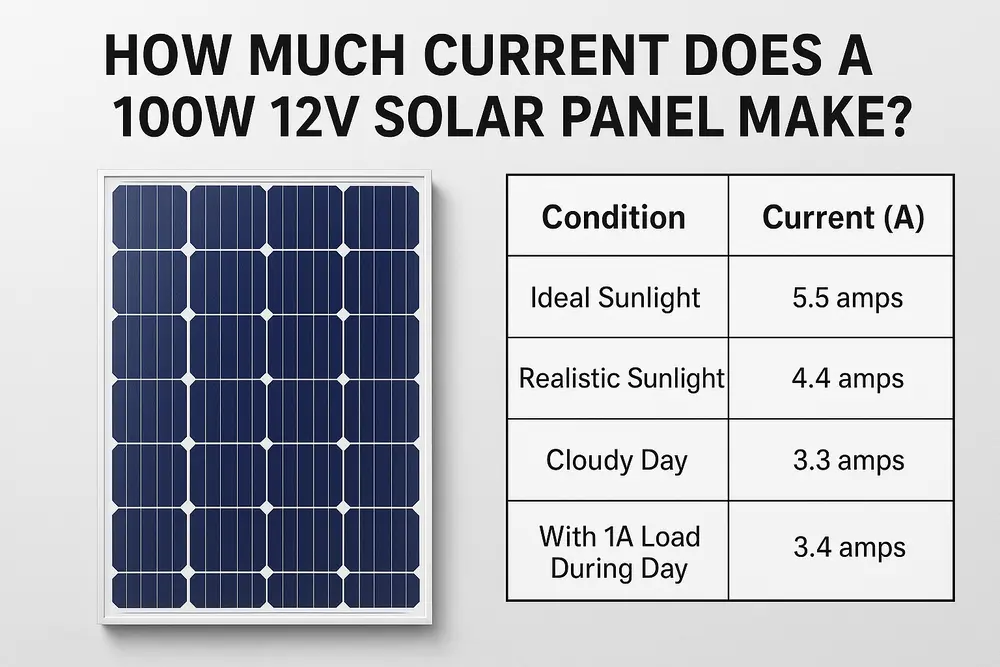A 100W 12V solar panel usually generates around 5.5 amps in perfect sunlight, but real-world conditions tend to decrease this. Things such as weather, angle of the panel, cleanliness, and type of controller all impact output. Let's discuss how these impact current and how to maximize your panel.
Understanding Solar Panel Current
Solar panels are rated in watts, which is a measure of power. To be expressed in current (in amperes), the operating voltage of the panel needs to be known. For a typical 12V solar panel, the voltage at maximum power (Vmp) will be around 18V. From a simple formula:
Current (A) = Power (W) / Voltage (V)
For a 100W panel:
I = 100W / 18 V ≈ 5.5 A
So under ideal conditions, a 12V 100W solar panel can produce approximately 5.5 amps. Certain high-efficiency panels can even reach 6.3 to 6.5 amps, depending on design.
Real-World Current Output
In the real world, solar panels rarely operate at their maximum rating due to environmental conditions. Here's how these conditions affect output:
- Weather Conditions: Cloudy or overcast days slash sunlight intensity, which lowers the panel's current. Output can drop from 5.5A to around 3.3–3.4A.
- Panel Angle and Position: Panels should face the sun and be positioned at a slight angle for optimal performance. An ineffective angle will reduce current significantly.
- Panel Quality and Cleanliness: Dirt, dust, or poor-quality panels will prevent sunlight from being absorbed, reducing current output.
- Charge Controller Type:PWM Controllers: Simpler and less efficient, will reduce voltage and current.MPPT Controllers: Adjust voltage to achieve maximum power, increasing effective current by 10–30% in most cases.
Daily Energy Production
To calculate daily energy, we multiply current by sunlight hours:
Ideal conditions (5.5A, 5 peak sunlight hours):
5.5 A × 5 h = 27.5 Ah
Can fully charge a 12V 36Ah battery.
Realistic scenario (4.4A average output, accounting for less-than-ideal conditions):
4.4 A × 5 h = 22Ah
Sufficient to charge most small 12V batteries in a day.
If you have a load on during the day, you need to subtract its current from the panel's output. A 1A daytime load, for example, reduces charging current to 3.4A, providing only 17Ah in 5 hours—about 47% of a 36Ah battery's capacity.
Practical Experience-based Tips
From my experience in installing and monitoring small solar installations:
- Keep panels clean: Dirt can reduce output by 10–15%.
- Use an MPPT charge controller: Enables you to get the most out of your 100W panel, especially in partially cloudy conditions.
- Consider battery type:
Lead-acid batteries require careful charging to avoid damage.
LiFePO4 batteries are more forgiving to partial discharge and give longer life.
Example
| Condition | Voltage (V) | Current (A) | Energy Produced (Ah/day, 5h sunlight) |
| Ideal Sunlight | 18 | 5.5 | 27.5 |
| Realistic Sunlight | 18 | 4.4 | 22 |
| Cloudy Day | 18 | 3.3 | 16.5 |
| With 1A Load During Day | 18 | 3.4 | 17 |
Solar Panel Efficiency Trends
New technology is even making small 100W panels more efficient. Developments include:
- Bifacial solar panels: Harvest light from the front and back, increasing current output.
- Better anti-reflective coatings: Reduce energy loss from sunlight that's reflected.
- Built-in smart controllers: Automatically adjust to maximize power in varying conditions.
These developments will have future 100W panels consistently producing closer to their rated 5.5–6A even in less-than-ideal conditions.
Conclusion
A 100W 12V solar panel will typically deliver 5.5A in perfect sunlight, but actual current can vary widely depending on weather, angle, cleanliness, and controller type. Understanding these variables allows you to properly size your system, avoid energy shortages, and choose appropriate batteries and inverters.
With the right planning and quality parts, even a small 100W panel can safely charge your 12V battery setup for daily off-grid or backup power.

